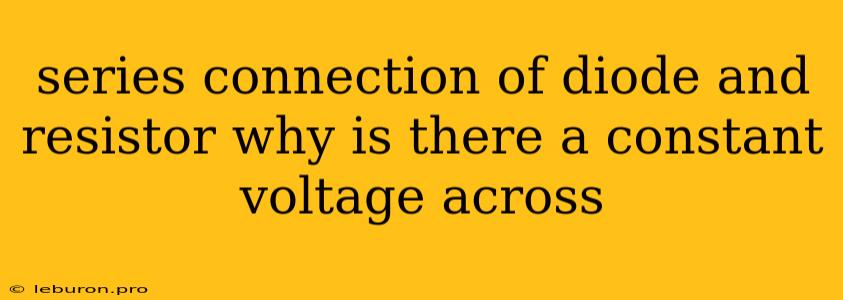The series connection of a diode and a resistor is a fundamental circuit configuration in electronics, often employed for various applications like voltage regulation, current limiting, and signal conditioning. Understanding the behavior of this circuit, particularly the constant voltage drop across the diode, is crucial for effective circuit design. This article delves into the reasons behind the constant voltage drop across the diode in a series connection with a resistor, exploring the underlying principles and practical implications.
Series Connection of Diode and Resistor
A series connection of a diode and a resistor typically involves connecting the diode's anode (positive terminal) to the resistor's one end, and the resistor's other end to the diode's cathode (negative terminal). This configuration allows for current to flow through both components sequentially. When a voltage is applied across the circuit, the diode's forward voltage drop and the resistor's voltage drop sum up to the total applied voltage.
The Diode's Role in Voltage Regulation
The diode's behavior in a series connection is governed by its unique property of having a relatively fixed forward voltage drop. This voltage drop, also known as the forward voltage (Vf), is characteristic of the specific type of diode used and remains fairly constant as long as the diode is forward biased. The forward voltage drop typically ranges from 0.6 to 0.7 volts for silicon diodes and around 0.2 to 0.3 volts for germanium diodes.
Forward Bias and Reverse Bias
For a diode to conduct current and exhibit its forward voltage drop, it needs to be forward biased. This means that the anode should be connected to a higher potential than the cathode. On the other hand, if the diode is reverse biased (cathode at a higher potential than the anode), it essentially acts as an open circuit, blocking the flow of current.
Why a Constant Voltage Drop Across the Diode?
The constant voltage drop across the diode in a series connection arises from the diode's pn junction characteristics. The pn junction forms the core of a diode, where a p-type semiconductor (with an excess of holes) is joined to an n-type semiconductor (with an excess of electrons). This junction creates a depletion region, devoid of free charge carriers, acting as a barrier to current flow.
When the diode is forward biased, the external voltage overcomes this barrier, allowing electrons from the n-type region to flow across the junction and recombine with holes in the p-type region. This recombination process creates a small voltage drop across the junction, which is essentially the forward voltage drop.
Dependence on Diode Type and Current
While the forward voltage drop is relatively constant, it does slightly increase with increasing current. This is because the junction's resistance, while generally low, is not completely negligible. However, this dependence is often minimal within the diode's operating range, making the forward voltage drop a useful characteristic for voltage regulation.
The Role of the Resistor
The resistor in the series connection plays a crucial role in controlling the current flow through the diode. The resistor's resistance determines the amount of current that can flow for a given applied voltage. By limiting the current, the resistor ensures that the diode operates within its safe operating parameters, preventing excessive current and potential damage.
Current Limiting
Consider the following scenario: A 12-volt DC supply is connected in series with a 100-ohm resistor and a diode with a forward voltage drop of 0.7 volts. The current flowing through the circuit is determined by the difference between the supply voltage and the diode's forward voltage drop, divided by the resistor's resistance:
Current (I) = (Supply Voltage - Diode Voltage) / Resistance
I = (12V - 0.7V) / 100 ohms
I = 0.113 amps
The resistor in this case limits the current to 0.113 amps, preventing excessive current flow and ensuring the diode operates within its safe limits.
Practical Applications
The series connection of a diode and a resistor finds applications in various electronic circuits:
1. Voltage Regulation
Due to its relatively constant voltage drop, a diode can act as a simple voltage regulator. In circuits where a stable output voltage is required, a diode can be used to clip off a portion of the input voltage. This is particularly useful for converting AC signals to DC or for protecting sensitive circuits from excessive voltages.
2. Current Limiting
The resistor in the series connection effectively limits the current flowing through the diode. This is essential for preventing excessive current from damaging the diode. By selecting an appropriate resistor value, the current can be controlled to within the diode's safe operating range.
3. Signal Conditioning
The series connection can be used to condition electrical signals. The diode can clip off unwanted signal peaks, while the resistor provides a load for the signal. This is particularly useful for applications like signal shaping or clipping, where the signal needs to be limited to a specific voltage range.
Conclusion
The series connection of a diode and a resistor is a versatile circuit configuration that leverages the diode's constant voltage drop for various applications. Understanding the constant voltage drop across the diode, its dependence on diode type and current, and the role of the resistor in current limiting is crucial for designing and analyzing circuits effectively. Whether it's for voltage regulation, current limiting, or signal conditioning, the series connection provides a simple yet powerful tool for controlling and manipulating electrical signals in electronic circuits.
